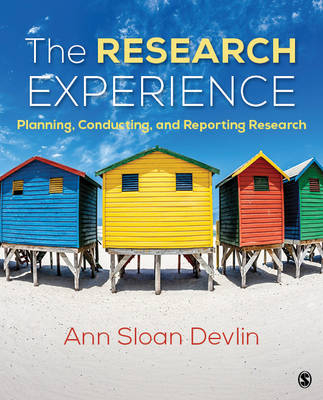
The Research Experience
SAGE Publications Inc (Verlag)
978-1-5063-2512-5 (ISBN)
- Titel erscheint in neuer Auflage
- Artikel merken
The Research Experience: Planning, Conducting, and Reporting Research presents a process-oriented approach to research for students in the behavioral sciences. In-depth, practical advice for conducting each step of the research process includes coverage of the most common research methods and current technologies—including Qualtrics, Google Scholar, and Amazon Mechanical Turk—as well as techniques for finding participants and collecting data in a variety of settings. With robust pedagogy and six helpful appendices, this text will further readers’ ability to produce well-executed projects and critically evaluate information in both their personal and professional lives.
Dr. Devlin is a published author with more than three decades of academic and research experience. During her more than 35 years as a faculty member at Connecticut College, she has taught courses in research methods, environmental psychology, cognitive psychology, industrial and organizational psychology, and a host of related seminars. She also established and frequently serves as chair or member of the Connecticut College Human Subjects Institutional Review Board (IRB). In those roles, she has reviewed more than 800 student research proposals as well as those of faculty and staff. With this experience, she is familiar with a wide range of research topics and research designs. Dr. Devlin has published four books, the most recent of which is Transforming the Doctor’s Office: Principles from Evidence-based Design (2015). Her third book, What Americans Build and Why: Psychological Perspectives (2010) focused on five facility types: residential, educational, medical, retail, and office. In addition, she has published numerous research articles in such journals as Environment and Behavior (SAGE), Journal of Environmental Psychology, Journal of Applied Social Psychology, Professional Psychology: Research & Practice, and Journal of Counseling Psychology.
Preface
About the Author
Introduction
Chapter 1 Research, Biases in Thinking, and the Role of Theories
Why Research Matters
The Research Process: Humans Make Predictions
Heuristics and the Work of Kahneman and Tversky
Other Problems in Thinking
Doing Science as Tradition and Innovation
Research and the Value of Common Sense
Flexibility in Thinking
Theories: What They Are and Why They Matter
Making a Connection Between a Theory and a Good Research Question
Summary
Chapter 2 Generating and Shaping Ideas: Tradition and Innovation
Overview
Ideas: Information Services, aka The Library
Ideas: Searching Effectively in the Library
Electronic Resources and Keywords
Keywords: The “Key” to Success
PsycINFO
Other Databases and Indexes in the Social Sciences
The Web and Peer Review
Particular Kinds of Articles
How Journals Differ: Issues Related to Quality
Open Access and Predatory Publishers
Publication Practices of Journals
Journal Articles Versus Book Chapters
Physically Obtaining an Article: A Closer Look at Databases
Summary of the Article Locator Search Process
Interlibrary Loan (ILL) Systems and World Catalog (WorldCat)
What to Do With Your Articles (Read More Than the Abstract!)
The Introduction
The Method Section
The Results Section
The Discussion Section: Conflicts and Gaps
Keeping Track: ILL, Mendeley, and RefWorks
Reasonable Questions and the Problem of Third Variables: Closing the Research Gap
Time Pressure and Timelines
Academic Fraud
Summary
Chapter 3 Research Design Approaches and Issues: An Overview
Overview
Research Quality Affects Research Answers
What Research Can Tell You: The Continuum of Certainty
Correlation Versus Causation
Why Conduct Correlational Research?
The Language of Correlation and Causation
Correlational Research Approaches: Correlational and Quasi-experimental
Hallmarks of True Experimental Approaches
Differentiation of Independent and Dependent Variables
Reframing a Research Idea
Type I Versus Type II Error
Type II Errors: Sample Size, Power, and Effect Size
Internal Validity
Behavior of the Experimenter and Demand Characteristics
Behavior of the Participant: Role Attitude
Single- and Double-Blind Approaches to Research
Cover Stories
Pilot Tests and Manipulation Checks
Summary of Additional Threats to Internal Validity
External Validity and Ecological Validity
Where Research Takes Place
Where Qualitative Research Takes Place
Summary
Chapter 4 Ethics and the Institutional Review Board (IRB) Process
Overview
What Is the IRB, and Why Does It Exist?
History of Ethical Oversight
The APA Code of Ethics
What Is Research? What Are Human Subjects?
IRB Membership and Duties
Levels of IRB Review
Components of the IRB Proposal
Informed Consent
Debriefing
Children as a Vulnerable Population: Implications for Research
Research With Children: Secondary Data Analysis
Deception and Its Alternatives
Ethics and Student Participation in Research: Alternatives to the Subject Pool
Offering Incentives in Research: Are Incentives Coercive?
Preparing an IRB Proposal
The IRB Training Modules
Summary
Chapter 5 Measures and Survey Research Tools
Overview
The Concept of Measurement: Ideal Versus Real
The Purpose of Measures
Measurement Scale Types
Sensitivity of a Scale and Anchor Values
The Process of Identifying Measures: The Literature
Databases of Tests (PsycTESTS and HaPI)
Books of Measures
Department Resources and Professors
Catalogs of Measures and Fees Charged
Qualities of Measures: Reliability and Validity
The Importance of Computing Your Own Cronbach’s Alpha
Qualities of Measures: Validity
Length and Difficulty of Measures
Instructions for Scoring
Names of Measures and Social Desirability Concerns
Qualifications for Use
Developing Your Own Instrument
Scale Types and Flexibility in Answering Research Questions
The Order of Questions in a Survey
Online Survey Software Tools
Features of Online Survey Software Programs
Program Features
Google Docs Forms
Downloading Online Surveys into SPSS
Survey Appearance
Summary
Chapter 6 Correlational and Qualitative Research
Overview
Correlational Research: General Characteristics
Questions Posed About the Sample
Drawbacks to Correlational Approaches
Correlational Design: Quasi-experimental Design (i.e., Questions About Groups)
Statistics Used in Correlational Designs
Qualitative Research
Qualitative Research and the Concept of Reflexivity
Acceptance of Qualitative Methodology in the Social and Behavioral Sciences
Qualitative Approaches to Research
How to Capture Behavior: Behavioral Categories
How Often and How Long to Observe
Calculation of Inter-rater Reliability (IRR)
Acceptable Values for Inter-rater Agreement
Participant and Nonparticipant Observation and Overt/Covert Observation
Ethnography: Extended Observation
Issues in Ethnography: Gaining Access
Initial Ethnographic Tours
Preserving Information
Grounded Theory
Phenomenology
Focus Groups
Interviews: Degrees of Structure
Recording or Not
Case Studies and Case Histories
Where Qualitative Meets Quantitative: Content Analysis
Summary of Steps in a Content Analysis
Computer-Assisted Qualitative Data Analysis Software (CAQDAS)
Qualitative Research and the Emotional Self: A Final Consideration
Summary
Chapter 7 Experimental Approaches: Between Subjects Designs
Overview
Between Subjects Designs: What Are They?
Characteristics of Between Subjects Designs: Advantages and Disadvantages
Sensitivity of IV
More on Power, Sample Size, and Power Calculations
Number of IVs and Interaction Effects
Evaluating an Interaction by Hand
Common Types of Between Subjects Design
Matched Groups Design
Multiple Comparisons
Handling Error Variance
Summary of Between Subjects Design Considerations
Finding and Creating IVs (Scenarios; Visual Images; Movie Clips; Auditory Clips)
Existing Literature: Method Section
Visual Images: Manipulating an Image
Multiple Dependent Variables (DVs) in a Research Design
Factor Analysis: An Overview
Summary
Chapter 8 Within, Mixed, Pre–Post Experimental, and Specialized Correlational Designs
Overview
Characteristics of Within Subjects Design: Advantages and Disadvantages
Types of Research Questions More Commonly Asked in Within Subjects Designs
Counterbalancing
Simple and Complex Within Subjects Designs
Adding Complexity to Within Subjects Designs
Mixed Designs
Pre–Post Designs: Characteristics
Types of Pre–Post Designs
Specialized Correlational Designs
Time-Series and Interrupted Time-Series Design
Strengths and Weaknesses of This Approach
When Is This Approach Used?
Real-World Challenges: Postoccupancy Evaluation (POE)
Longitudinal and Cross-Sectional Designs
Advantages and Disadvantages of the Longitudinal Approach
Advantages and Disadvantages of the Cross-Sectional Approach
Cohort-Sequential Design
Advantages of Using Multiple Methods
Summary
Chapter 9 Recruiting Participants
Overview
Who Participates in Research: An Overview
The Subject Pool: The Workhorse of Social Science Research
The Drawbacks to Subject Pools: Concerns About Internal Validity
Limits on the Number of Participants Available From Unpaid Subject Pools
Keeping Track of Participants: Online Participant Management Systems
Practical Issues in Communicating About Recruiting
Research on Sensitive Topics and the Role of the IRB
Recruiting Off Campus
Using Your Personal Connections
Using Your Institution’s Connections
Bureaucracy
Vulnerable Populations in the Community
Physical Security Issues in Conducting Research off Campus
Service Learning Courses and Recruiting Participants: Opportunities and Complications
Conflicts of Interest and Multiple Relationships
Dustin’s Dozen: Tips for Collecting Data in the Field
Identifying Information
Other Sources of Participants: The Online Approach
Online Use of Adverts (Advertisements) Versus Snowball Samples
Ethical Issues in Online Environments: The Facebook Emotional Contagion Study
Sampling
Nonresponse Bias and Threats to Internal Validity
Nonresponse and Nonresponse Bias
Response Rates and Reporting Them
Incentives: Practical Issues
Amazon Mechanical Turk (MTURK): The World Awaits
Questions of Validity in Using Amazon MTURK
Online Paid Panels
Summary
Chapter 10 Organizing Data and Analyzing Results
Overview
Paper and Online Surveys: An Overview
The Importance of Labeling
Labeling in a Data File and Deciding on a Coding System
Other Labeling Recommendations
Labeling Issues in Online Survey Software
Entering Individual Items Versus Item Totals
Backing Up Data
Dealing With Missing Data: Differing Points of View
Replacing Missing Data Through Single Value Imputation
Some Recommendations for Missing Data
Identifying Missing Data
Handling Out-of-Range Values
Handling Outliers
Going Fishing and Other Data Dredging Practices
Ethics, Cleaning Up, and Reporting Your Data: Final Comments
Preliminary Analyses
Significance Levels and p Values: What Are They?
Transforming and Selecting Data: Useful Commands in SPSS
Summary of Data Organization Steps
Evaluating Your Hypotheses: Where to Begin
Making Use of Free Response Items
Additional Aids: Online Calculators and Word Clouds
Other Statistical Software
Summary
Chapter 11 Writing and Presenting Your Research
Overview
Writing: One Section at a Time
Writing: Avoiding Plagiarism
The Writing Itself: Clear and Simple
The “Shape” of Your Paper
The Title of the Paper and Its Importance
The Abstract
The Introduction: Content
The Method Section
Writing About Results
Discussion
Nonsignificant Results: What Can You Say?
Statistical Versus Practical Significance
General Formatting Issues: Mastering APA Style
Presenting Numbers: The Short Story
Common Grammatical Mistakes
Creating Conference Presentations
Summary
Highly Recommended Papers
Appendices
Appendix A: Decision Tree for Statistical Analysis
Appendix B: Sample Informed Consent Document
Appendix C: Sample Debriefing Statement
Appendix D: Resource Guide to Commonly Used Measures
Appendix E: Commonly Used Analyze Functions in SPSS
Appendix F: Scale Types and Associated Statistical Analyses for Common Research Approaches
Glossary
References
Name Index
Subject Index
| Erscheinungsdatum | 19.03.2017 |
|---|---|
| Verlagsort | Thousand Oaks |
| Sprache | englisch |
| Maße | 187 x 231 mm |
| Gewicht | 830 g |
| Themenwelt | Geisteswissenschaften ► Psychologie ► Allgemeines / Lexika |
| ISBN-10 | 1-5063-2512-2 / 1506325122 |
| ISBN-13 | 978-1-5063-2512-5 / 9781506325125 |
| Zustand | Neuware |
| Haben Sie eine Frage zum Produkt? |
aus dem Bereich



